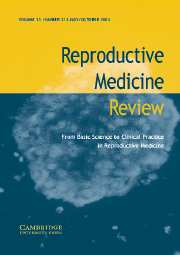Article contents
Antifertility effects of antigestogens
Published online by Cambridge University Press: 02 March 2009
Extract
Since the discovery of the structure and function of steroids over 60 years ago, it has long been recognized that synthetic antagonists of the natural hormones would have potential therapeutic uses. Antagonists of mineralocorticoids, androgens and oestrogens, for example spironolactine, cyproterone, flutamide and tamoxifen, have already found a place in the management of hormone dependent conditions. In 1982, chemists at Roussel UCLAF announced that they had synthesized mifepristone (RU486) 17β-hydroxy-11(p-(dimethylamino)phenyl)-17-(1-propynyl) estra-411, 9-dien-3-one) a derivative of norethindrone which had potent antiprogestogenic as well as antiglucocorticoid activity. Although it was immediately realised that this compound would potentially have wide clinical application, its development in the last 10 years has been dominated by its abortifacient action. In the original clinical report by Herrman and colleagues it was shown that bleeding occurred when it was given to female volunteers in the second half of the menstrual cycle. In addition, complete abortion occurred in eight of 11 women who took the drug in the early weeks of pregnancy. These findings, which demonstrated that mifepristone could be used as the basis of a medical method of inducing abortion, were immediately made the focus of groups opposed to abortion on moral grounds. Experience over the last 10 years has confirmed the promise of these early studies and mifepristone, in combination with a suitable prostaglandin, is now licensed in France, UK and Sweden for use as a medical method of inducing abortion in early pregnancy.
- Type
- Articles
- Information
- Copyright
- Copyright © Cambridge University Press 1993
References
- 2
- Cited by


